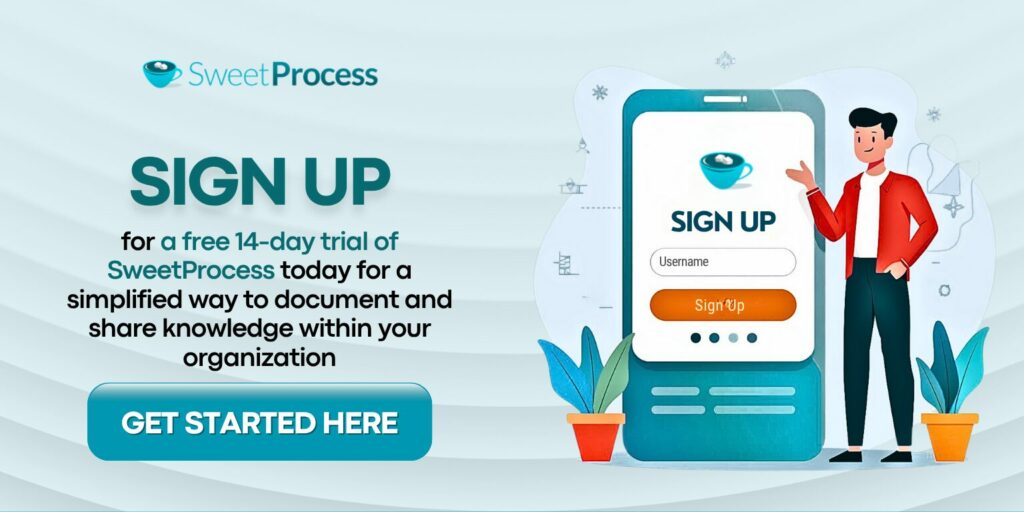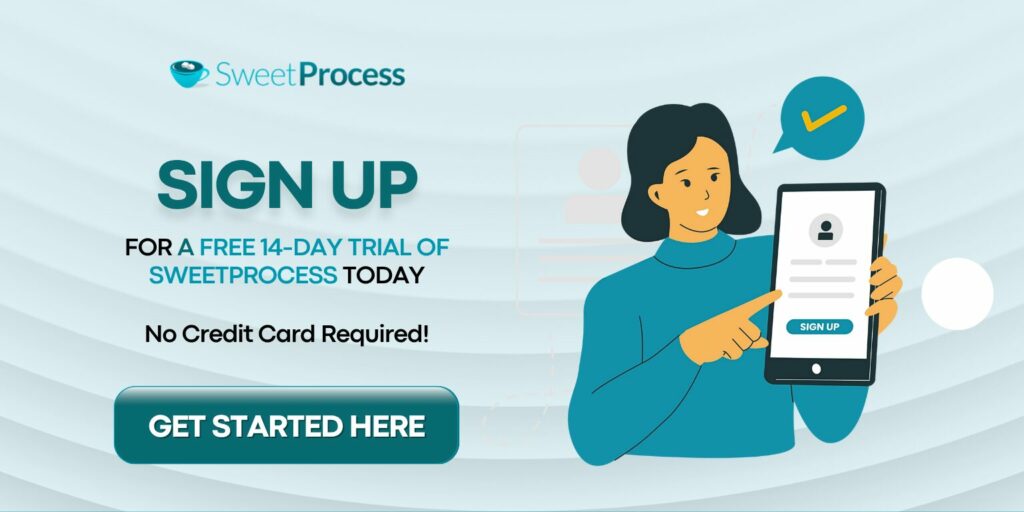Last Updated on October 25, 2025 by Owen McGab Enaohwo

How much valuable information is sitting quietly in your team’s heads right now, untapped and at risk of disappearing?
Every organization has its go-to people: the ones everyone relies on for answers, quick fixes, and workarounds. The sales rep who knows exactly how to close tricky deals, the customer support agent who has solved that recurring tech issue a dozen times, or the operations manager who has figured out the fastest way to get through compliance paperwork.
If these team members left the company tomorrow, all that undocumented knowledge goes with them, leaving frustrated employees and unhappy customers. That’s why knowledge sharing is so essential in ensuring the business doesn’t come to a stop in these situations. In this guide, we’ll explore what knowledge sharing is, why it matters, the different ways to do it, and a step-by-step process to get you started.
Want a simple way to document and share knowledge within your organization? SweetProcess makes it easy by providing wikis and centralized knowledge bases that your whole team can access. Sign up here to start your 14-day free trial!
Table of Contents
Why Is Knowledge Sharing Important?
How To Share Knowledge in the Workplace: A Step-by-Step Process
How To Streamline Knowledge Sharing With SweetProcess
Knowledge Sharing Versus Knowledge Management
Build a Knowledge Sharing Culture in Your Workplace Using SweetProcess
What Is Knowledge Sharing?
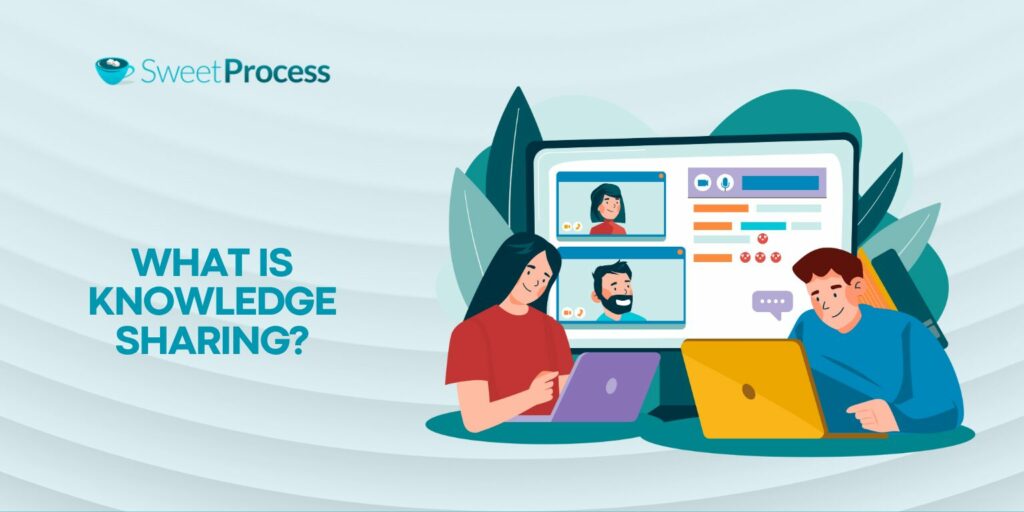
Knowledge sharing involves exchanging information, skills, or expertise among people or teams within an organization. The goal of this process is to improve learning, decision-making, and overall performance of your business.
As a critical part of knowledge management, this process reduces tribal knowledge and ensures the organization becomes less dependent on specific individuals. The insights gained from hands-on work and years of experience can be documented and made accessible to the rest of the team.
For instance, a seasoned customer service rep might document not just what the official support script says, but the “why” behind it, the quick tricks they’ve learned over time, and the warning signs of issues most employees overlook. When this knowledge is captured in a centralized location, it prevents others from repeating avoidable mistakes.
Project manager Kierstyn Ferreira shares how important it is to have a knowledge base during a project. She explains that having a centralized folder accessible to everyone (after being vetted) is invaluable. It is especially helpful for new team members, serving as a guide to how the team thinks and works so they can get up to speed with the culture much faster.
This insight highlights the vital purpose of knowledge sharing in creating continuity and building organizational assets.
Why Is Knowledge Sharing Important?
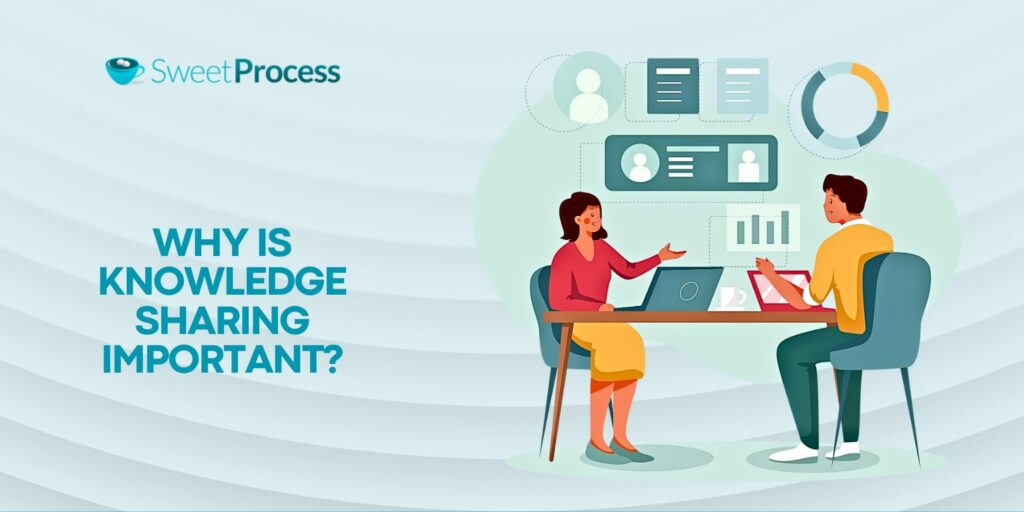
For your team to be on the same page, you need to implement proper knowledge sharing systems. There’s a ripple effect when one person’s know-how becomes collective knowledge. Let’s break down the specific benefits:
Improved Productivity & Efficiency
You don’t want your team to spend hours digging for the same information every time there’s a new customer query. When there’s a shared guide, work gets done faster with fewer errors. For example, if your sales team has a record of successful pitches and responses to objections, every representative, even new hires, can use these proven strategies instead of wasting time experimenting with less effective approaches.
Additionally, team members don’t have to ask the manager the same questions repeatedly, especially when they need to execute a task. This way, they have more time to focus on critical tasks and grow the business.
Faster Onboarding
Remember when you were a new hire. The first days can be intimidating as you learn about your role. This feeling is much worse if most of the team’s knowledge is invisible and scattered.
However, if the documented processes, FAQs, and best practices are shared, the recruits get access to a roadmap from day one. A searchable knowledge base builds competence and morale early on, making new employees feel like productive team members faster.
Reduced Training Costs
Data by Statista shows that midsize companies across the U.S. spend approximately 53 hours to train one employee. If you add up these costs for every new hire, it becomes costly for your organization. Instead of relying on traditional live sessions, you can use a knowledge-sharing platform that centralizes all your training manuals and resources.
Training becomes on-demand, as employees revisit these materials at any time without requiring a trainer’s presence. Additionally, managers don’t have to repeat the same explanations for every new team member, saving both time and money.
Enhanced Innovation & Collaboration
Knowledge sharing ensures different departments have access to the same knowledge, which sparks innovation. For instance, when the marketing team shares customer feedback with product development, or operations shares workflow bottlenecks with leadership, employees start collaborating, leading to creative problem-solving.
Once you break down the knowledge silos, you can encourage employees to think bigger, build on each other’s ideas, and drive innovation across the organization.
Supports Employee Development
You can also encourage your employees to grow professionally by making it easy to learn from the experiences of others. Access to diverse perspectives, case studies, and lessons learned is more likely to stretch their skills and help them explore new opportunities. For instance, a junior manager might study documented leadership strategies used by senior executives and apply them in their role.
Over time, this type of peer-to-peer learning helps employees become more versatile, confident, and prepared for future leadership roles. In this way, knowledge sharing becomes an investment in both personal growth and the company’s long-term success.
Prevents Tribal Knowledge
If seasoned team members quit or retire, they leave with the knowledge acquired. And with nearly 50% of employees leaving or changing jobs each year, the chances of losing critical tribal knowledge are higher than most businesses realize.
Knowledge sharing protects against this loss by transferring expertise from individuals to the wider team. If all the standard operating procedures (SOPs) have been documented on a company knowledge base, your business will continue operating as usual since employees have a reference point.
How To Share Knowledge in the Workplace: A Step-by-Step Process
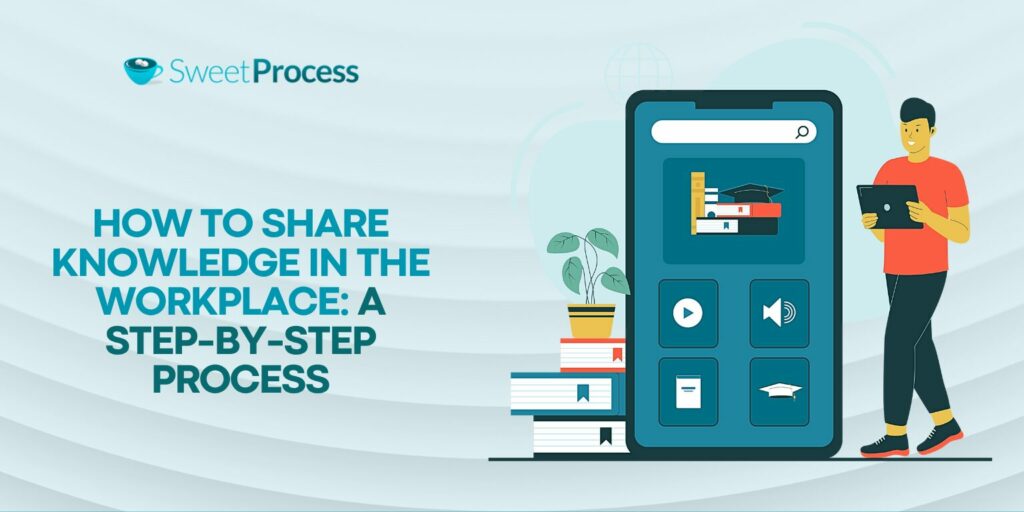
Whether you want to create a knowledge-sharing system or reinvent the one you have, here is a step-by-step process to keep you aligned:
Step 1. Discover or Create Valuable Knowledge
Not every piece of information qualifies for sharing. You first need to identify what knowledge your team needs. To identify this, you can examine customer interactions, recurring issues, key company policies, or innovative ideas from your company’s brainstorming sessions.
For example, if the HR team wants to share critical new policies for remote working, these details can be compiled and added to an accessible knowledge system. You can also encourage a culture where employees proactively share insights and information that should be added to your knowledge hub.
Step 2. Capture and Document Knowledge
Once knowledge is identified, the next step is to document it before it gets lost. Documentation can take the form of step-by-step SOPs, checklists, or even short explainer videos. You can also write a knowledge base article, especially if you are a subject matter expert on specific topics, to capture the necessary information.
This process ensures that knowledge is not only held by a few team members. As you document the knowledge, ensure that it’s simplified, making it easy for new hires or clients to follow without needing extra guidance.
Step 3. Organize and Structure Information
Without structure, your company’s knowledge might become confusing and useless. You need to properly categorize the documents in a way that employees can find them and understand how they fit into their workflows. If you are in the product team, you can categorize the documents into sections such as design, testing, and deployment, making it easier to follow.
Additionally, using consistent tags, folders, or categories makes information less overwhelming for employees who are in a rush to solve a problem. When you have updates, you can add the new information to the existing knowledge base, instead of having multiple documents.
Step 4. Store Knowledge in Accessible Systems
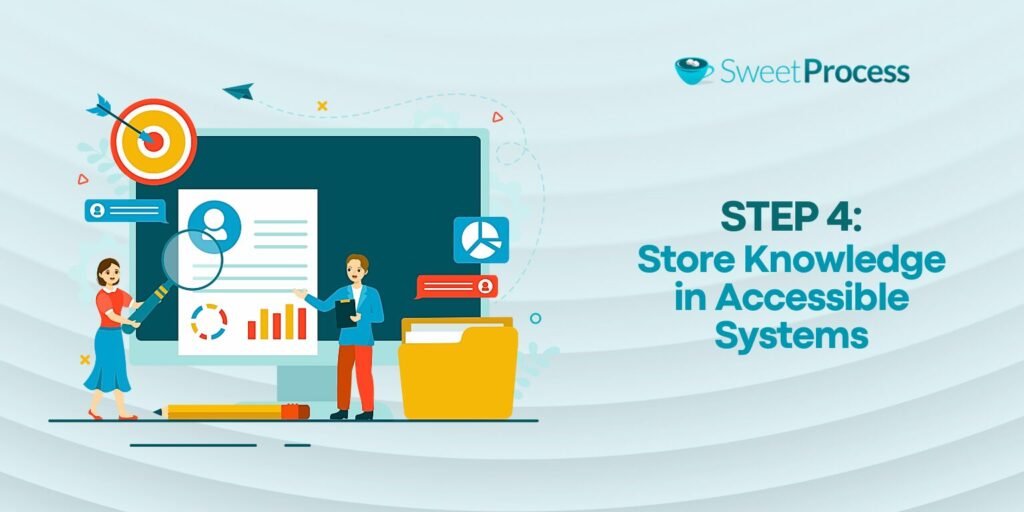
If your knowledge is stored in scattered emails, personal drives, or sticky notes, it’s practically invisible to the team. The best practice is to have it all on a shared system, such as a company wiki or knowledge base that everyone can access.
For example, instead of sending updated policies by email, the HR team can upload them to the company’s knowledge base software, where employees can always find the latest version. If access is difficult, employees will bypass it and revert to old habits and procedures.
Step 5. Review and Update Regularly
Once you create a knowledge base, the work doesn’t stop there. You must keep it updated to reflect your organization’s current environment, both internal and external. When you make improvements, such as software upgrades, you should revise the troubleshooting guide so that your employees aren’t following outdated instructions.
To make this process effective, you can assign the work to team members who will be responsible for keeping the resources fresh. You can also set intervals that dictate whether the knowledge will be reviewed quarterly or annually. This approach helps employees trust that the knowledge base is accurate and worth using.
Step 6. Share and Distribute Knowledge
After capturing the knowledge, you have to make it actionable. Distributing the information ensures that all team members are aware of the new changes. For instance, if the marketing team documents a new campaign playbook, they can distribute it to sales so that both teams are aligned on messaging and expectations.
These updates can be shared in team meetings or quick Slack notifications, referring the employees to the knowledge base. You can also share the new guidelines directly from the knowledge platform, either in text or visual form, which actively prevents silos and creates transparency across departments.
Step 7. Apply and Reuse Knowledge in Practice
If the knowledge is documented but not applied in real practice, it becomes obsolete. Your team should implement the SOPs, guides, or processes shared to avoid repeating mistakes in a new project. Reusing knowledge in multiple projects saves you time and builds a culture of continuous improvement.
As you apply the knowledge, you can also spot issues that require fixing.
When done right, knowledge sharing will help you achieve your business goals. SweetProcess makes this process seamless by providing a platform to document, organize, and distribute knowledge in one place. Try it for free here!
How To Streamline Knowledge Sharing With SweetProcess

Knowledge sharing is only as effective as the systems supporting it. You need a comprehensive knowledge management system, such as SweetProcess, that allows you to document your processes and exchange ideas within the same platform. You can run multiple knowledge bases for different teams and control access for your team and clients.
Due to its versatility, this tool works for processes such as employee onboarding, product development, customer support, and accounting management. Let’s walk through exactly how you can use SweetProcess to transform your knowledge-sharing efforts:
Document Organizational Procedures, Policies, and Processes in SweetProcess
With SweetProcess, you can document all the key procedures, policies, and processes on a single platform. Therefore, when an employee leaves, retires, or even takes time off, their expertise is accessible to the rest of the team.

Procedures can be broken down into step-by-step guides that anyone can follow:
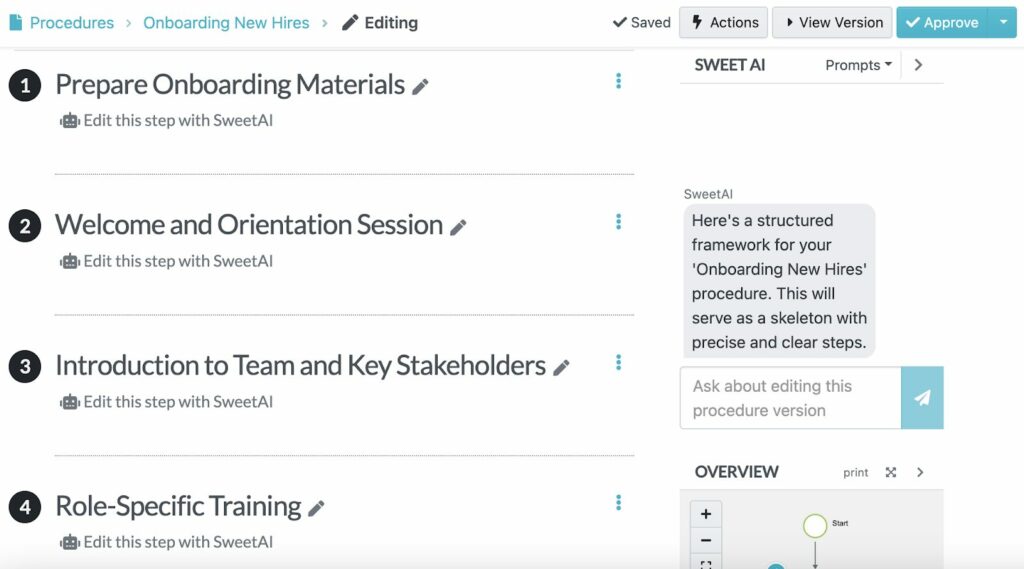
From the dashboard, you can also choose the option to create processes if that’s what your team needs.

The management or HR team can also update new policies that everyone needs to follow, right from the SweetProcess dashboard.

As you create this documentation, you can add images, videos, or tables to make the processes, procedures, and policies clearer and more detailed. Once you save and publish the documents, they become available for everyone with the necessary permissions.
Collaborate on Company Documentation and Tasks
With knowledge sharing, teams need to contribute, review, and refine information together. SweetProcess makes collaboration seamless by enabling multiple team members to co-create and update documents in real time.
Document collaboration prevents silos. Instead of one department hoarding knowledge, everyone contributes, creating a shared resource that grows richer over time.
For instance, teams across different departments can co-edit a document.
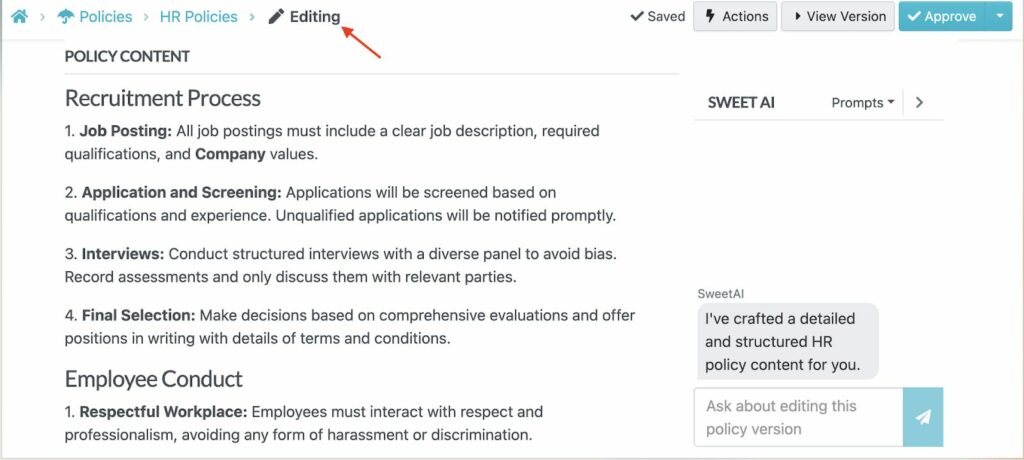
You can also add a comment and tag a colleague to suggest an idea.
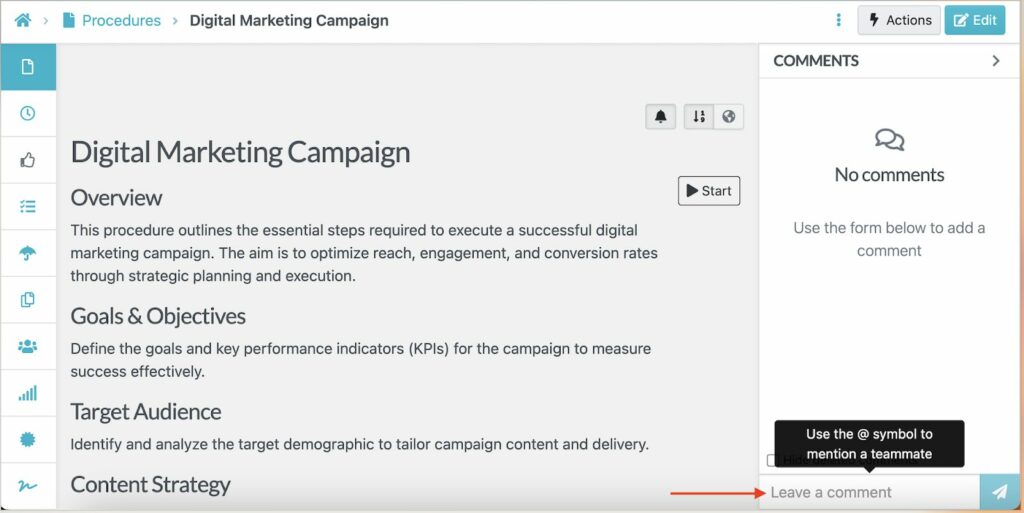
Additionally, you can assign tasks to other team members within SweetProcess to make it a collaborative process.

Manage Access With the Team Feature on SweetProcess
Not all information should be available to everyone in your company. For example, HR policies around compensation or legal compliance may only be relevant to specific groups. SweetProcess solves this with its team feature, which lets you control who sees what.
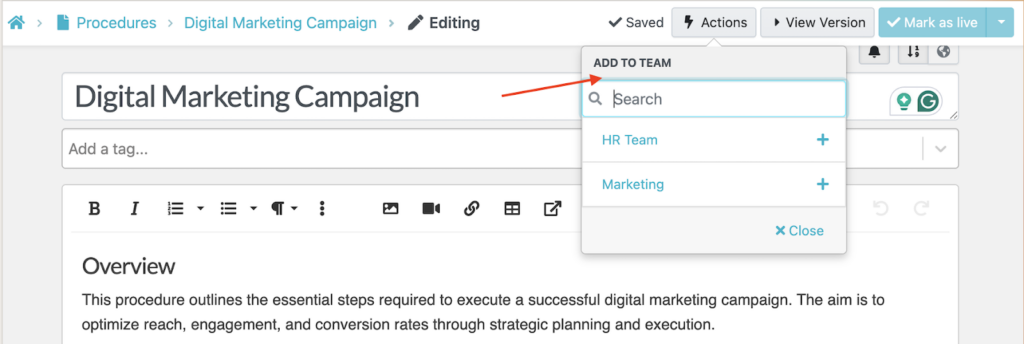
Alternatively, you can assign documents or procedures to the relevant teams.
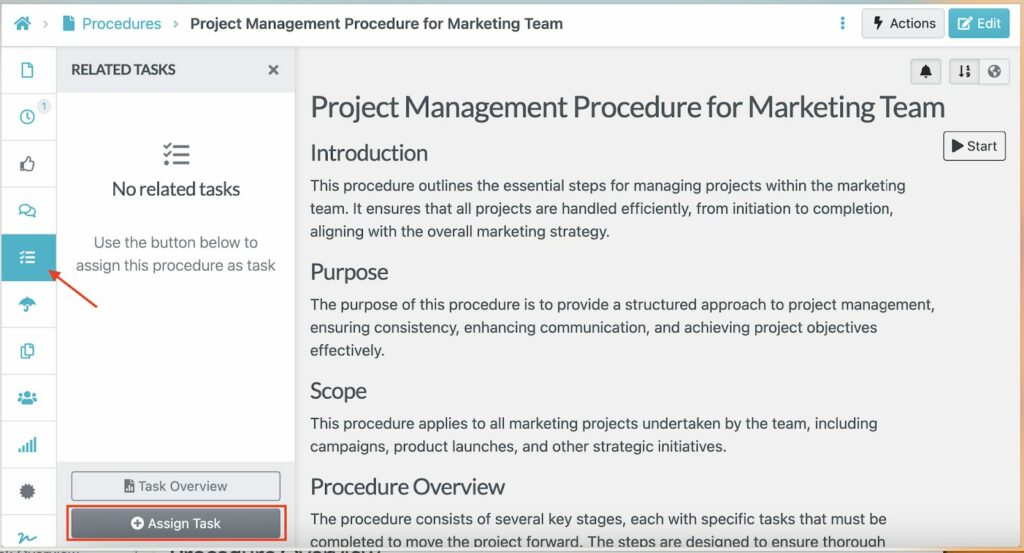
Controlling access balances transparency with security. It ensures employees have the knowledge they need without overwhelming them with irrelevant documents or exposing sensitive information unnecessarily.
Create and Manage Multiple Knowledge Bases Within SweetProcess
Most organizations have different audiences for their knowledge, including employees, contractors, and customers. SweetProcess allows you to create multiple knowledge bases, each tailored to its audience.
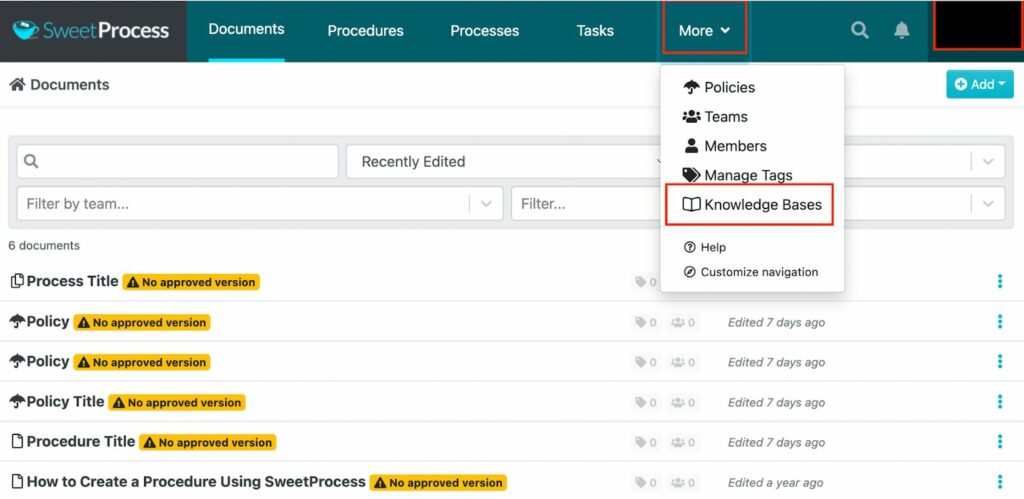
This feature is vital since it allows you to separate information hubs. For instance, employees can access an internal knowledge base for SOPs.

On the other hand, you can create an external knowledge base for customers.
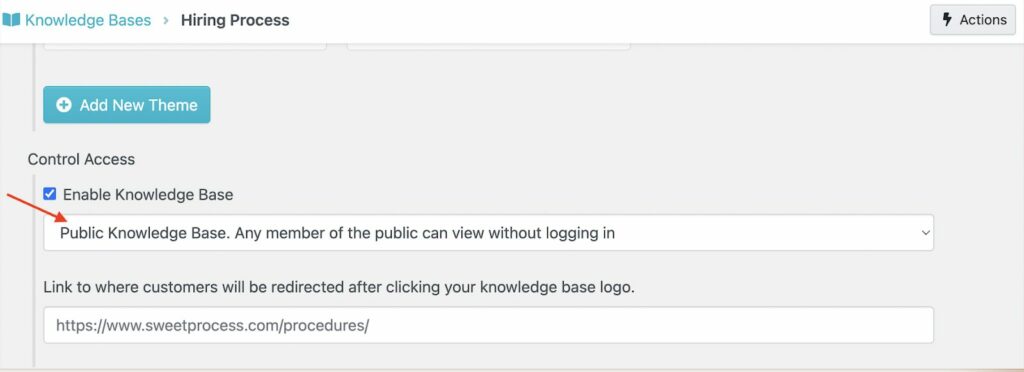
Manage Procedures, Workflows, and Knowledge Bases in One Place
When you have multiple tools for task assignments, process documentation, and knowledge management, your team can get confused. SweetProcess centralizes all the workflows, saving your team time.
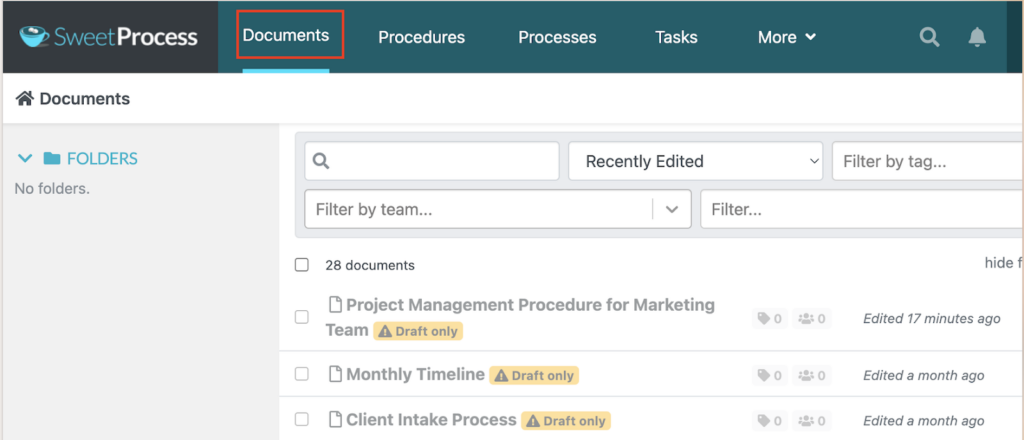
Employees don’t waste hours searching for the right document or logging into different platforms. The search feature makes it easy to find the specific document you need.

These features have been put into practice by organizations across different industries. Let’s look at a few real-world examples.
Property management firm, All Residential Real Estate, had for years struggled with inefficient documentation. While the company increased its portfolio of properties, the Managing Director, Perry Beebe, realized that paper-based checklists quickly became outdated. Therefore, employees often had no clear instructions on how to complete tasks, leading to inconsistency and overreliance on a few people in the office.
Looking for a way to streamline operations and modernize his business, Perry turned to SweetProcess. Thanks to this shift, the company has gained:
- Effective documentation: They are no longer reliant on subject matter experts; every process is well documented and accessible.
- Faster onboarding & training: New hires simply log into SweetProcess, follow step-by-step guides, and get up to speed quickly.
- Consistent operations: Standardized procedures ensure employees perform tasks the same way every time, reducing errors and boosting client satisfaction.
- Stronger knowledge base: Instead of scattered checklists, the company now uses SweetProcess’s knowledge base feature to keep operations centralized and auditable.
Another organization that has transformed its knowledge sharing practices using SweetProcess is the Texas Department of Family and Protective Services (DFPS). Each year, the agency processes over 40,000 record requests. But with such a massive workload, their old system of Word manuals, SharePoint files, Excel sheets, and endless email memos was inefficient.
Information was scattered, hard to update, and difficult for staff to navigate. Some manuals ran over 200 pages and could take up to a year to update. Frustrated by outdated documentation, management analyst Heather MacLean and her colleague Justin Compton sought a better way to organize and streamline operations, which led them to SweetProcess.
With SweetProcess, they now have:
- Streamlined documentation: Long manuals were replaced with simple, step-by-step procedures that are easy to create, update, and follow.
- Captured tribal knowledge: Tasks once known only to individual employees are now documented and stored, ensuring continuity when roles change.
- Faster onboarding and cross-training: New staff can now access clear instructions for repeatable tasks, making training smoother.
- Remote knowledge access: Cloud-based storage and permission controls mean staff can securely access the right processes from anywhere.
- Actionable management insights: Supervisors can see how often processes are accessed, making it easier to measure staff engagement and identify training needs.
Types of Knowledge Sharing
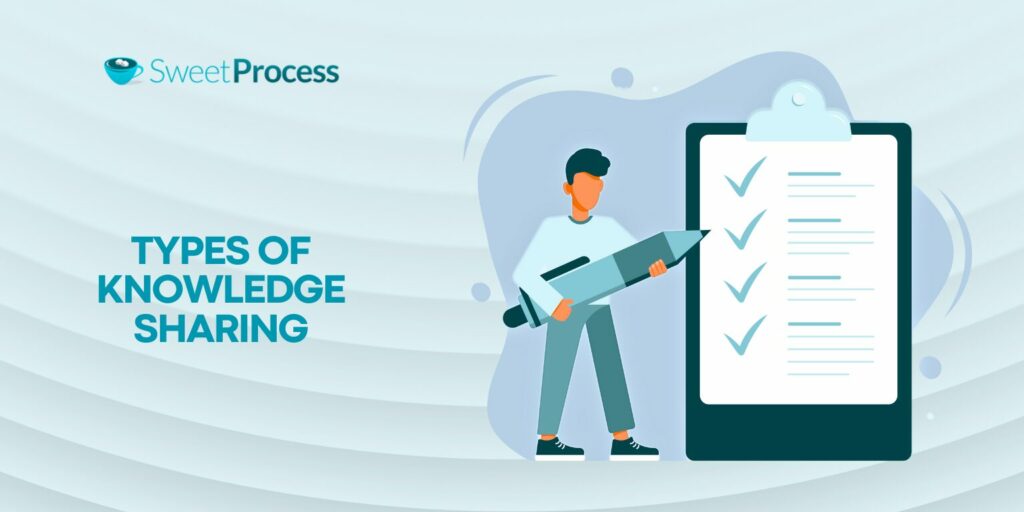
Now that we know the right tool to share knowledge, what types of information exist in an organization? Knowledge differs because some of it is easy to write down, while other parts are hidden in people’s experience, intuition, or even company systems.
Once you understand the different types of knowledge sharing, you can identify the best way to capture and transfer knowledge. Here are the main types:
Implicit Knowledge Sharing
You just hired a new social media manager for the marketing team. During their first week, they observe the senior marketing manager’s approach when creating content to post across different platforms. Over time, the new employee internalizes the process and starts applying the skills learned.
This is how implicit knowledge is shared among employees through observation and practice. For instance, if some of the information is not formally documented, they can learn by watching and doing. It can also be transferred through shadowing, mentoring, or on-the-job training following the existing processes and procedures.
If you want to strengthen implicit knowledge sharing within your business, you can pair new hires with experienced staff or encourage practice where employees learn by working together.
Explicit Knowledge Sharing
Explicit knowledge is the easiest type to transfer because it’s already documented in manuals, SOPs, spreadsheets, or wikis. For example, if you have a step-by-step checklist for onboarding a new client, it’s explicit knowledge; therefore, it can be read, understood, and applied by anyone.
For this to be effective, you need to ensure that the explicit knowledge is centralized, easy to find, and up-to-date. If your processes are spread across Google Docs, emails, and personal drives, employees waste valuable time searching.
Tacit Knowledge Sharing
Think of the veteran project manager who can sense when a timeline is at risk before any red flags show on a spreadsheet. These insights are shaped by intuition, personal experiences, and practice; therefore, this type of knowledge can be the hardest to capture if you lack the proper sharing systems.
Organizations often lose tacit knowledge when senior employees retire or move on without sharing information they’ve gathered over the years. To prevent this, you can set up mentorship programs, encourage storytelling during team meetings, or create case studies where subject matter experts share how they solved real challenges.
This approach ensures the company doesn’t lose essential information.
Declarative Knowledge Sharing
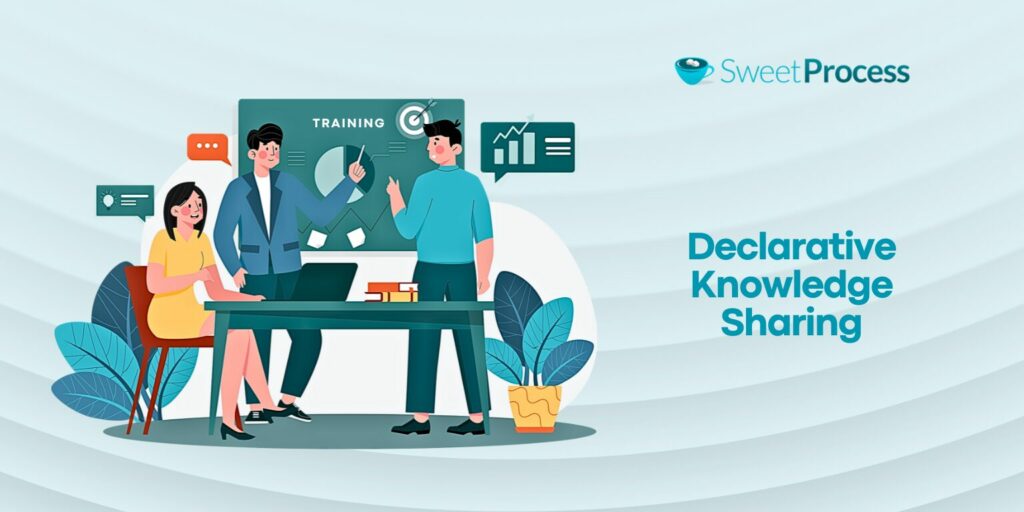
Declarative knowledge covers facts, concepts, or information that everyone needs to know. It often shows up in training materials, compliance documents, or product specifications. For instance, the legal team or the quality assurance department may be more knowledgeable about definitions and quality standards everyone should follow.
Sharing this type of knowledge ensures that employees are aligned on these requirements. This information is vital in preventing errors and inconsistencies.
Procedural Knowledge Sharing
Procedural knowledge focuses on the how, detailing the specific steps to carry out a task. For example, how to file a customer refund, how to submit payroll, or how to process a support ticket. Without consistent procedural knowledge sharing, every employee does things in their own way, leading to errors.
The best way to capture and share procedural knowledge is through documenting step-by-step guides, process maps, and checklists that leave no room for guesswork. Many companies also use simulations in training to help employees practice procedures before applying them in real situations.
Embedded Knowledge Sharing
Embedded knowledge is typically hidden within systems, processes, and routines. For instance, your company might have an automated email sequence that welcomes new customers and already knows the right timing and messaging. You could also have software that prevents employees from moving forward until they complete a required step.
Although powerful and efficient, embedded knowledge can create challenges if the systems change and employees don’t understand the reason behind it. Because of this, it’s essential to document how tools and workflows function so that employees can understand why they occur. This ensures the organization can adapt without losing valuable built-in knowledge.
Each type of knowledge plays a unique role in how your company runs. Your organization should take deliberate steps to capture and share knowledge using tools like SweetProcess. Start your free trial today!
Modes of Knowledge Sharing

Knowledge in organizations evolves through interaction. The SECI model, developed by Nonaka and Takeuchi, describes how knowledge is continuously created and transformed in workplaces in four key modes. Let’s break down each mode:
Socialization
This process involves sharing tacit knowledge via imitation, hands-on collaboration, and observation. The best depiction of this mode is when you have junior teams sit beside senior managers or supervisors, watching how they approach a problem. For instance, in a hospital setting, a nursing student shadows a senior nurse to understand bedside communication with patients.
Organizations that encourage mentorship programs, apprenticeships, or job-shadowing make socialization a natural part of the workplace. It’s especially useful for capturing knowledge that isn’t documented.
Externalization
Externalization converts tacit knowledge into explicit knowledge. This involves turning personal experience into something that can be shared and reused by the rest of the team. For example, a call center supervisor who has been with your team for years can draft a knowledge base article on “10 De-Escalation Techniques That Work in High-Stress Calls” to guide the new hires.
This way, information that was once held by one individual becomes a company-wide resource. Externalization happens through writing SOPs, creating training videos, or conducting knowledge-sharing sessions. By capturing employee expertise in tangible formats, organizations can reduce the risk of losing critical knowledge when employees leave.
Combination
Once you have different types of explicit knowledge, you can merge and reorganize it to create extensive resources. The combination process ensures that all the documented sources are well-connected. You could combine customer feedback, industry research, and sales data into a marketing playbook that your business can use for all product launches.
This mode is vital for eliminating knowledge silos within departments and across the company since all related documents are centralized.
Internalization
Now that the information is readily available, the employees can internalize it. This mode transforms the explicit knowledge back into tacit knowledge by applying the skill. At this stage, the new hire has absorbed all the documented information and used it in real situations until it gradually becomes part of their skill set.
When your team members internalize the shared knowledge, they don’t need to keep reading the manuals and guides. The more employees apply documented knowledge, the more skilled the organization becomes.
Want to make this cycle seamless in your organization? SweetProcess helps you capture, organize, and share knowledge at every stage of the SECI model. Start your free trial today and see how easy knowledge sharing can be.
Knowledge Sharing Versus Knowledge Management
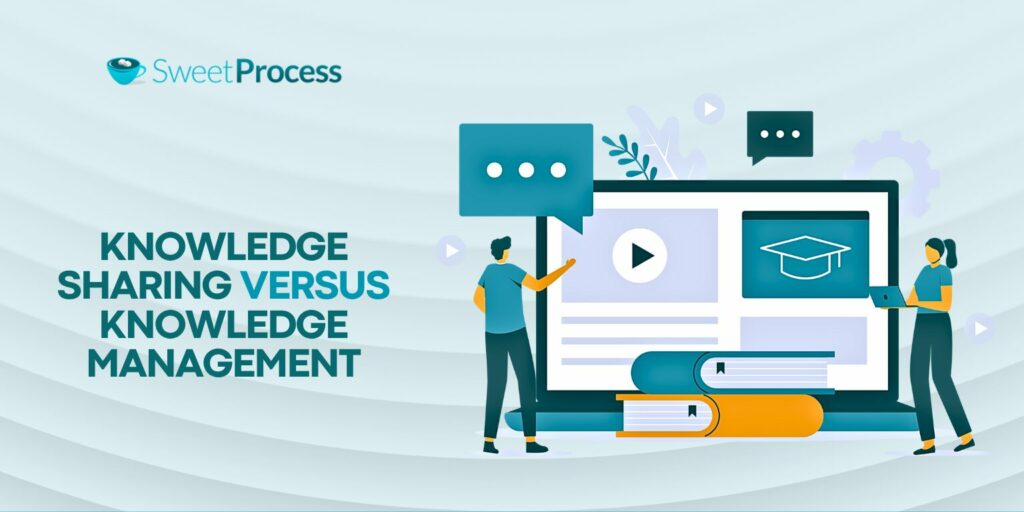
While knowledge sharing and knowledge management might seem like the same thing, they have distinct differences.
Knowledge sharing primarily involves exchanging information to make it accessible to others. On the other hand, knowledge management is a broader system that includes identifying, drafting, and organizing the company’s intellectual assets in one location. This process ensures that your FAQs, technical documents, wikis, and training materials are properly managed so that they can be easily shared.
Both processes prevent knowledge loss and ensure that experiences, lessons, and best practices are available to everyone. In addition, they require systems and tools to work well. This is why organizations need knowledge management software to preserve institutional memory in the long term.
Build a Knowledge Sharing Culture in Your Workplace Using SweetProcess
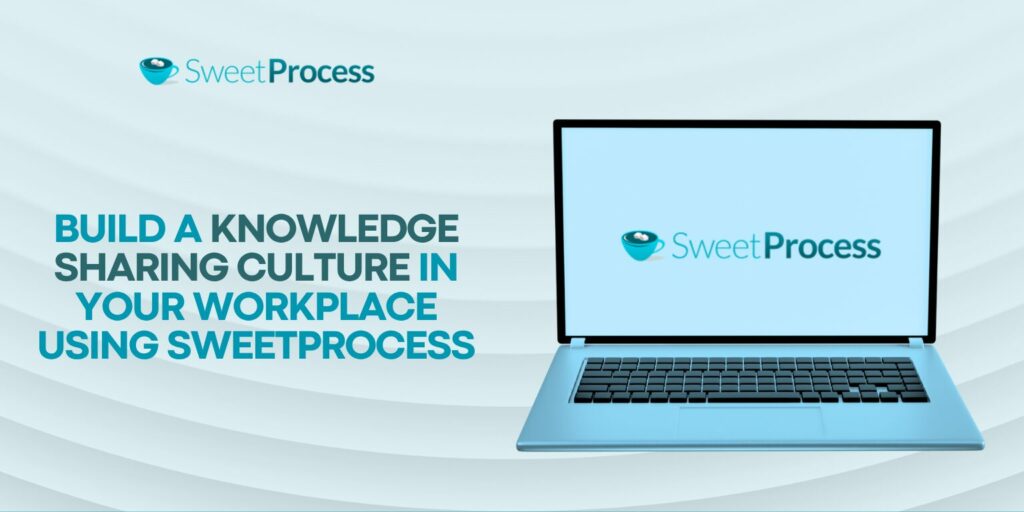
Behind every great organization are employees with insights, skills, and experiences worth sharing. The challenge isn’t whether that knowledge exists; it’s whether it’s being captured and shared. Teams that have a knowledge-sharing culture are more efficient, consistent, and better prepared for business growth.
One of the best ways to protect your company’s most valuable information is by using the right solutions. SweetProcess brings in an intuitive platform to capture and share knowledge, whether you need to onboard new hires or document best practices. Once you centralize your knowledge, it becomes easier to build your organization’s collective expertise.
Try SweetProcess today and give your organization the knowledge-sharing culture it needs to keep scaling. No credit card is required!
